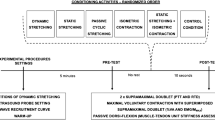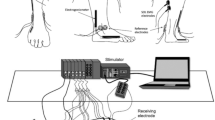Abstract
The purpose of this study was to investigate whether acute passive stretching (APS) reduced maximal isometric voluntary contraction (MVC) of the plantar flexors (PF) and if so, by what mechanisms. The PF in 15 female volunteers were stretched for 10 min (5×120 s) by a torque motor to within 2° of maximum dorsiflexion (D) range of motion (ROM). MVC with twitch interpolation, maximal Hoffmann reflex (Hmax) and compound action potentials (Mmax) were recorded at 20° D. Stretch reflexes (SR) were mechanically induced at 200° s−1 between 0° and 10°D and SR torque and EMG amplitude were determined. All tests were assessed pre- (pre) and post-APS (post-test1). MVC, SR, and Mmax were again assessed after additional stretch was applied [mean 26 (1)° D; post-test2] to test if the optimal angle had been altered. EMG was recorded from soleus (SOL), medial gastrocnemius (MG) and tibialis anterior (TA) using bipolar surface electrodes. APS resulted in a 27% decrease in mean peak passive torque (P<0.05). MVC and SR torque were 7% (P<0.05) and 13% lower at post-test1 (P<0.05), respectively. SR EMG amplitude of SOL and MG was reduced by 27% (P<0.05) and 22% (P<0.05), respectively. The Hmax/Mmax EMG and Hmax/Mmax torque ratios were unchanged at post-test1. At post-test2, MVC and SR EMG recovered to pre-APS values, while the SR and Mmax torque increased by 19% and 13%, respectively (P<0.05). The decrease in MVC during post-test1 was attributed to changes in the mechanical properties of PF and not to reduced muscle activation.








Similar content being viewed by others
References
Avela J, Kyröläinen H, Komi PV (1999) Altered reflex sensitivity after repeated and prolonged passive muscle stretching. J Appl Physiol 86:1283–1291
Bonjiovanni LG, Hagbarth KE, Stjernberg (1990) Prolonged muscle vibration reducing motor output in maximal voluntary contractions in man. J Physiol (Lond) 423:15–26
Clausen T (2003) Na+-H+ pump regulation and skeletal muscle contractility. Physiol Rev 83:1269–1324
Cupido CM, Galea V, McComas AJ (1996) Potentiation and depression of the M wave in human biceps brachii. J Physiol (Lond) 491:541–550
Davidoff RA (1992) Skeletal muscle tone and the misunderstood stretch reflex. Neurology 42:951–963
Dowling JJ, Konert E, Ljucovic P, Andrews DM (1994) Are humans able to voluntarily elicit maximum muscle force? Neurosci Lett 179:25–28
Dulhunty AF, Franzini-Armstrong C (1977) The passive electrical properties of frog skeletal muscle fibres at different sarcomere lengths. J Physiol (Lond) 266:687–711
Elder GCB, Kirk J, Stewart G, Cook K, Weir D, Marshall A, Leahey L (2003) Contributing factors to muscle weakness in children with cerebral palsy. Dev Med Child Neurol 45:542–550
Fowles JR, Sale DG, MacDougall JD (2000) Reduced strength after passive stretch of the human plantarflexors. J Appl Physiol 89:1179–1188
Fukunaga T, Roy RR, Shellock FG, Hodgson JA, Day MK, Lee PL, Kwong-Fu H, Edgerton VR (1992) Physiological cross-sectional area of human leg muscles based on magnetic resonance imaging. J Orthop Res 10:926–934
Gollhofer A, Schopp A, Rapp W, Stroinik V (1998) Changes in reflex excitability following isometric contraction in humans. Eur J Appl Physiol 77:89–97
Haylar EM, Stolov WC, Venkatesh B, Brozovich FV, Harley JD (1978) Gastrocnemius muscle belly and tendon length in stroke patients and able-bodied persons. Arch Phys Med Rehabil 59:476–484
Hugon M (1973) Methodology of the Hoffmann reflex in man. In: Desmedt JE (ed) New developments in electromyography and clinical neurophysiology, vol 3. Karger, Basel, pp 277–293
Kennedy PM, Cresswell AG (2001) The effect of muscle length on motor-unit recruitment during isometric plantar flexion in humans. Exp Brain Res 137:58–64
Kent-Braun J (1999) Central and peripheral contributions to muscle fatigue in humans during sustained maximal effort. Eur J Appl Physiol 80:57–63
Kouzaki M, Shinohara M, Fukunaga T (2000) Decrease in maximal voluntary contraction by tonic vibrations applied to a single synergist muscle in humans. J Appl Physiol 89:1420–1424
Kubo K, Kanehisa H, Kawakami Y, Fukunaga T (2001) Influence of static stretching on viscoelastic properties of human tendon structures in vivo. J Appl Physiol 90:520–527
Lin JP, Brown JK, Walsh E (1997) Soleus muscle length, stretch reflex excitability, and the contractile properties of muscle in children and adults: a study of the functional joint angle. Dev Med Child Neurol 39:469–480
Magnusson SP (1998) Passive properties of human skeletal muscle during stretch maneuvers: a review. Scand J Med Sci Sports 8:65–77
Magnusson SP, Simonsen EB, Aagard P, Gleim GW, McHugh MP, Kjaer M (1995) Viscoelastic response to repeated static stretching in the human hamstring muscle. Scand J Med Sci Sports 5:342–347
Magnusson SP, Simonsen B, Aagard P, Kjaer M (1996) Biomechanical responses to repeated stretches in human hamstring muscle in vivo. Am J Sports Med 24:622–628
Moore MA, Kukulka CG (1991) Depression of Hoffman reflexes following voluntary contraction and implications for proprioceptive neuromuscular facilitation therapy. Phys Ther 71:321–333
Rosenbaum D, Hennig EM (1995) The influence of stretching and warm-up exercises on Achilles tendon reflex activity. J Sports Sci 13:481–490
Sale D, Quinlan J, Marsh E, McComas AJ, Belanger AY (1982) Influence of joint position on ankle plantarflexion in humans. J Appl Physiol 52:163–1642
Taylor DC, Dalton JD, Seaber AV, Garrett WE (1990) Viscoelastic properties of muscle-tendon units—the biomechanical effects of stretching. Am J Sports Med 18:300–309
Thigpen LK, Moritani, T, Thiebaud R, Hargis JL (1985) The acute effects of static stretching on alpha motoneuron excitability. In: Winter DA, Norman RW, Wells RP, Hayes KC, Patla AE (eds) Biomechanics IX-A. Human Kinetics, Champaign, Ill.
Toft E, Sinkjaer T, Espersen GT (1989a) Quantitation of the stretch reflex: technical procedures and clinical applications. Acta Neurol Scand 79:384–390
Toft E, Sinkjaer T, Kalund S, Espersen GT (1989b) Biomechanical properties of the human ankle in relation to passive stretch. J Biomech 22:1129–1132
Acknowledgements
The equipment used in this study was purchased from a prior grant from the Hospital for Sick Children Foundation, Toronto, Canada. The authors would like to thank Mr. Wayne Zelmer for his extensive assistance with programming and electronic support and Dr. J. Fowles for reviewing this manuscript. This experiment complied with the Canadian TriCouncil Policy Statement on the Ethical Conduct for Research Involving Human Subjects.
Author information
Authors and Affiliations
Corresponding author
Rights and permissions
About this article
Cite this article
Weir, D.E., Tingley, J. & Elder, G.C.B. Acute passive stretching alters the mechanical properties of human plantar flexors and the optimal angle for maximal voluntary contraction. Eur J Appl Physiol 93, 614–623 (2005). https://doi.org/10.1007/s00421-004-1265-4
Accepted:
Published:
Issue Date:
DOI: https://doi.org/10.1007/s00421-004-1265-4




